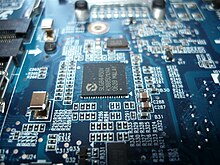
Electrical engineering

Electrical engineers design complex power systems …

… and electronic circuits.
Electrical engineering is a field of engineering that generally deals with the study and application of electricity, electronics, and electromagnetism. This field first became an identifiable occupation in the latter half of the 19th century after commercialization of the electric telegraph, the telephone, and electric power distribution and use. Subsequently, broadcasting and recording media made electronics part of daily life. The invention of the transistor and, subsequently, the integrated circuit brought down the cost of electronics to the point where they can be used in almost any household object.
Electrical engineering has now subdivided into a wide range of subfields including electronics, digital computers, power engineering, telecommunications, control systems, RF engineering, signal processing, instrumentation, and microelectronics. The subject of electronic engineering is often treated as its own subfield but it intersects with all the other subfields, including the power electronics of power engineering.
Electrical engineers typically hold a degree in electrical engineering or electronic engineering. Practicing engineers may have professional certification and be members of a professional body. Such bodies include the Institute of Electrical and Electronic Engineers (IEEE) and the Institution of Engineering and Technology (IET).
Electrical engineers work in a very wide range of industries and the skills required are likewise variable. These range from basic circuit theory to the management skills required of project manager. The tools and equipment that an individual engineer may need are similarly variable, ranging from a simple voltmeter to a top end analyzer to sophisticated design and manufacturing software.
History
Electricity has been a subject of scientific interest since at least the early 17th century. The first electrical engineer was probably William Gilbert who designed the versorium: a device that detected the presence of statically charged objects. He was also the first to draw a clear distinction between magnetism and static electricity and is credited with establishing the term electricity.[1] In 1775 Alessandro Volta’s scientific experimentations devised the electrophorus, a device that produced a static electric charge, and by 1800 Volta developed the voltaic pile, a forerunner of the electric battery.[2]
19th century

The discoveries of Michael Faraday formed the foundation of electric motor technology.
However, it was not until the 19th century that research into the subject started to intensify. Notable developments in this century include the work of Georg Ohm, who in 1827 quantified the relationship between the electric current and potential difference in a conductor, Michael Faraday, the discoverer of electromagnetic induction in 1831, and James Clerk Maxwell, who in 1873 published a unified theory of electricity and magnetism in his treatise Electricity and Magnetism.[3]
Beginning in the 1830s, efforts were made to apply electricity to practical use in the telegraph. By the end of the 19th century the world had been forever changed by the rapid communication made possible by engineering development of land-lines, submarine cables, and, from about 1890, wireless telegraphy.
Practical applications and advances in such fields created an increasing need for standardized units of measure. They led to the international standardization of the units volt, ampere, coulomb, ohm, farad, and henry. This was achieved at an international conference in Chicago 1893.[4] The publication of these standards formed the basis of future advances in standardisation in various industries, and in many countries the definitions were immediately recognised in relevant legislation.[5]
During these years, the study of electricity was largely considered to be a subfield of physics. It was not until about 1885 that universities and institutes of technology such as Massachusetts Institute of Technology (MIT) and Cornell University started to offer bachelor’s degrees in electrical engineering. The Darmstadt University of Technology founded the first department of electrical engineering in the world in 1882. In that same year, under Professor Charles Cross at MIT began offering the first option of electrical engineering within its physics department.[6] In 1883, Darmstadt University of Technology and Cornell University introduced the world’s first bachelor’s degree courses of study in electrical engineering, and in 1885 the University College London founded the first chair of electrical engineering in Great Britain.[7] The University of Missouri established the first department of electrical engineering in the United States in 1886.[8] Several other schools soon followed suit, including Cornell and the Georgia School of Technology in Atlanta, Georgia.
-

Thomas Edison electric light and (DC) power supply networks
-

Károly Zipernowsky, Ottó Bláthy, Miksa Déri, the ZDB transformer
-

William Stanley, Jr., transformers
-

Galileo Ferraris, Electrical theory, induction motor
-

Nikola Tesla, Practical polyphase (AC) and induction motor designs
-

Mikhail Dolivo-Dobrovolsky developed standard 3 phase (AC) systems
-

Charles Proteus Steinmetz, AC mathematical theories for engineers
-

Oliver Heaviside, developed theoretical models for electric circuits